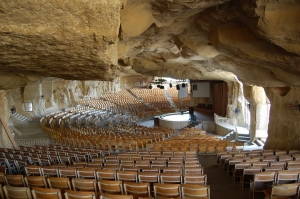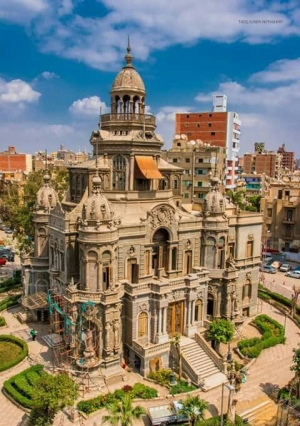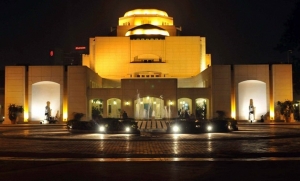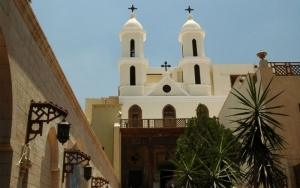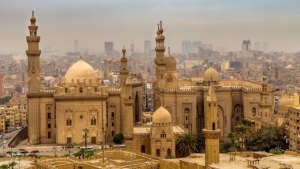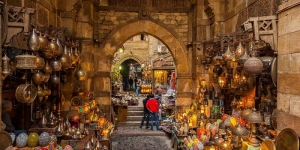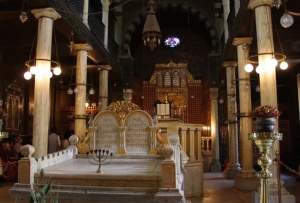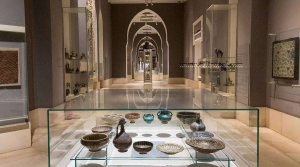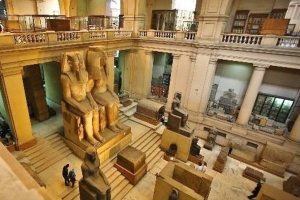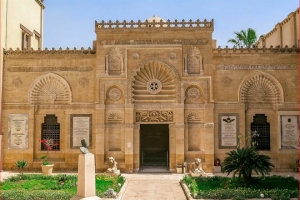+2 0122-345-3028
This email address is being protected from spambots. You need JavaScript enabled to view it.
Super User
Samaan El Kharaz Cave Church
Samaan El Kharaz Cave Church
Mokattam Hills
The church of Smaaan El Karaz was found and established in the Mokattam Mountain, looking over the city of Cairo, in a district near the "Mokattam Garbage Village" what a strange place for a church
Hundreds of years ago, at the same site a miracle happened when a ruler asked the Coptic Patriarch to prove his faith. It is mentioned in the Bible: If you have faith as small as a mustard seed, you can ask the mountain to move and it will. As mentioned in the "Church History" the Patriarch called upon the people to pray. He saw a vision: The Virgin Mary gave him a clue about the man who would lead them in their prayers.
That was Samaan, a man of true faith. The people prayed and the mountain moved up and down as they shouted; "God have mercy"
The ruler fearfully asked him to stop praying after it was clear that there was truth about faith and what it can do.
Now the site contains five churches on the mountain and in the caves. It is designated as a tourist site. It is a nice commemoration to the miracle
Artists are making sculptures on the stones and rocks of the mountain.
Sakakini Palace
Sakakini Palace
In el daher area just a few blocks away from Ramses Train Station in the Area of the resident of The Elite during the 40th and 50th of the Last century, the palace of sakakini Pasha is hidden in the middle of quite a busy area. Upon arrival, one instantly wonders what the urban surroundings must have looked like in 1897, at the time of its construction.
Location, the area was named after the creator of the Palace, Habib Sakakini Pasha (1841-1923), a Levantine descent businessman whose family immigrated to Egypt at the beginning of the 19th century. It is said that he came to the country when he was 16 years old and worked his way up, finally becoming a rich contractor. The Arabic name Sakakini can be translated as "knife-maker", which some say he earned from his trade in the arms and knives business.
The rococo style and quite fancy architecture of the palace is said to be taken from an Italian palace that Habib Pasha saw and fell in love with. He then ordered an Italian company to create a replica of it in Cairo. The architectural rococo style of the facades was common at the time in Europe, but quite rare in Egypt.
He chose quite an impressive site for his home. The palace stands high in a focal location where eight main roads radiate out, hence making it the center point of the zone. Acquiring such a distinguished location normally would have not been an easy task at the time. However his good connection with the Khedive allowed him such privileges.
opera house
Opera House
The Cairo Opera House Has a Long history in Cairo as the fist opera House were Build in Cairo 1868 in Central Cairo what is known now is Midan el Opera just a front of The Ibrahim Pasha Statue
In 70th the Old opera House were burden in a huge fire
Them to build it up the New opera House they decide to move it place Near the Nile river at the edge of Zamalek Island
The new 7 -story opera house at the Gezira Exhibition Grounds was inaugurated on October, 3, 1988.
Designed by a team of Japanese and Egyptian architects, it is an architectural masterpiece of Islamic design.
It is equipped with the most sophisticated audio-visual system and comprises:
1.The Main Theater, a closed hall comprising 1200 seats, is used for opera, ballet, and classic music performance.
2.The Second Theater is also a closed hall comprising 500 seats and is used for various purposes, including film festivals and conferences.
3.The Third Theater is open and comprises 1000 seats.
There are other halls, some of which are used for training and rehearsals. In addition, the Museum and the Library contain references pertaining to the most significant artistic works.
old Coptic
Old Cairo Chruches
Old Cairo Churches
Old Cairo is the historic link between Egypt’s pharaonic and Islamic civilizations. Here, the fortress-town of Babylon, where the Holy Family is thought to have taken refuge, developed into a power house of native Christianity which today remains the heart of Cairo’s Coptic community.
Old Cairo is also known as the district of the seven churches, which are the Church of Abu Serga (Church of St Sergius), the Hanging Church (Al Mo’allaqa Church), The Church of St Barbara, The monastery of St George , The Greek Orthodox Church of St George,The Church of St George (Church of Mari Guirguis) and the Church of the Virgin .
Nestled between the Hanging Church and the Roman towers of Babylon, The Coptic Museum is one of the highlights of Old Cairo, which houses a rare collection of Christian antiquities.
The Church of Abu Serga
The church is dedicated to Sergius and Bacchus, who were soldier-saints that were martyred during the 4th century in Syria by Maximilan. The original building was probably built in the 5th century. It burnt down during the fire of Fustat around 750 AD. It was restored during the 8th century, and has been rebuilt and restored constantly since medieval times. It is said to be an ideal model of the early Coptic churches. The Church of Abu Serga retains the basilical form typical of early Coptic churches. The low ceiling and the antique columns topped with Corinthian capitals support the women’s gallery, where you can inspect its thirteenth-century haikal screen and bits of frescoes and mosaics in the central apse. It has 12 unique columns decorated with paintings of the Apostles. This church resembles religious structures in Constantinople and Rome. The main attraction is the Steps to the right of the altar descending into a crypt which contains the remains of the original church where the Holy Family are believed to have stayed.
• The Church of St Barbara
It is one of the most beautiful Coptic Churches. The eleven-century Church of St Barbara replaced an earlier Church of SS. Cyrus and John, which was razed during Al-Hakim’s assault on Fustat. Unlike others in the quarter, its wooden-vaulted roof is lofty, with skylights and windows illuminating a nave flanked by Arabic arches with Fatimid tie beams. The same goes for its minbaresque pulpit and inlaid haikal. The right-hand wall relates the life of Jesus in colorful tableaux, while the western sanctuary contains the relics of St Barbara. Tradition holds that she was the daughter of a pagan merchant who was murdered for preaching Christianity in the third century.
• The Hanging Church
It was built over the remains of the southern gate of the Roman Fortress of “Babylon”. Therefore it was called “the Hanging Church” or Al Mu’allaqah.
The church was first built, in Basilcan style, in the 3rd or 4th century. The main church is thought to have been built between the 5th and 6th centuries with the southeastern section called the "upper church" being added later. The church was destroyed in the 9th century. It was rebuilt in the 11th century and became the seat of the Coptic patriarch until the 14th century. It became known to travelers during the 14th and 15th centuries as the "staircase church" because of the twenty-nine steps that lead to the entrance.
The main nave – whose ceiling is ribbed like an upturned boat or Ark- is separated from its side aisles by sixteen pillars, formerly painted with images of saints. Behind the marbel pulpit, beautifully carved screens hide three haikals (altar areas) from the congregation. Their star patterns are accentuated by inlaid bone and ivory.
Among its relics, the Church owns an olive stone chewed by the Virgin Mary , to whom El-Mu’allaqah is dedicated.
• The Monastery of St George
The monastery of St George is now the seat of the Greek Orthodox Patriarchate of Alexandria. The main building of the monastery is closed to visitors. But you can walk down into a lofty hall once belonged to a Fatimid mansion and into the Chapel beyond, with its tall, narrow wooden doors, which boasts a cedar wood casket containing relics of St George. To the left of this building is a small room for the “chain-wrapping ritual”, sympolizing the saint’s persecution by the Romans.
• The Greek Orthodox Church of St George
This Church is the only one in Egypt with round dome, its dark interior is perfumed with incense and pierced by sunbeams filtered through stained glass. A (barred) flight of steps descends into the bowels of the Roman Tower. The present church was built in 1904 after a fire destroyed the original tenth-century structure
• The Church of St George
This church is founded in 681 by Athanasius the scribe. From the original foundation only the Hall of Nuptials survived a conflagration in the mid-nineteenth century, after which the current structure was erected.
• The Church of the Virgin,
This church is also identified by its alternative name of Qasriet Al-Rihan (Basil Pot) after the favorite herb of the Orthodox Church. Because Al-Hakim’s mother was of that faith , the church was given to the Greek community for the duration of his reign, but later returned to the Copts. Largely rebuilt in the eighteenth century, it’s chiefly notable for several icons painted by John the Armenian in 1778
mosques
Mosques
THE MOSQUE OF AMR IBN AL-AAS
The mosque of Amr Ibn al-Aas, built in 642 (21 H) and said to be build on the site of Amr Ibn el-As's tent at Fustat, is the oldest existing mosque, not just in Cairo, but the entire African Continent. Located north of the Roman Fortress of Babylon, It is actually on the edge of Fustat, the temporary city founded by Amr, and was an Islamic learning center long before El-Azhar Mosque. It could hold up to 5,000 students. The mosque incorporates elements of Greek and Roman buildings, and has 150 white marble columns and three minarets. Simple in design, its present plan consists of an open sahn (court) surrounded by four riwaqs, the largest being the Qiblah riwaq. There are a number of wooden plaques bearing Byzantine carvings of leaves, and a partially enclosed column is believed to have been miraculously transported from Mecca on the orders of Mohammed himself. There are many other ancient legions related to the Mosque. Its current form is derived primarily from a renovation in 1798 by Murad Bey.
THE IBN TULUN MOSQUE
Build by Ahmed Ibn Tulun in 879 (265 H), the Ibn Tulun Mosque in the Sayyedah Zeinab district has an atmosphere of tranquility unlike that of any other mosque in the city. Ahmed Ibn Tulun was sent to govern Cairo by the Abbasid Caliph in Baghdad, which explains the Mesopotamian influence. It is the oldest original mosque and the largest in Egypt. It incorporates a number of unique features, such as the external spiral staircase of the unusual minaret (the only one of its type in Egypt) which is similar to the famous Samarra Mosque in Mesopotamia. It's design is simple, consisting of an open sahn with an ablution fountain in the center, surrounded by four riwaqs, the largest being the Qiblah riwaq. (The Qiblah side is the side closest to Mecca.) There are five naves on the Qiblah side, and two on the remaining sides the building style follows that of the Abbasid type, characterized by pilasters on which slightly pointed arches are applied, and which have a slight inward curve at the bottom. The rectangular building surrounding the sahn has a rampart walk.
And the high walled additions (Ziyyadahs) are found on the south, west and north. Within the prayer niche, or mihrab, constructed of marble and gilded mosaic and bordered by four columns with leaf like crowns, is a wonderful pulpit, or minbar of 13th (Mameluke) century origin. Many of the 13th century restorations were carried out by Sultan Lajin, who at one point took refuge in the mosque and vowed to restore. The stone carvings on the interior walls are elegant and the designs of the rondels {128 latticed windows made of gypsum} are distinct and unusual. Running around the interior of the four arcades are original Koranic inscriptions carved in sycamore. It was used as a military hospital by Ibrahim Pasha during the 19th century and was later used as a salt warehouse and beggar's prison prior to it's restoration in 1918.
THE AL-AZHAR MOSQUE
The Al-Azhar Mosque (the most blooming), established in 972 (361 H) in a porticoed style shortly after the founding of Cairo itself, was originally designed by the Fatimid general Jawhar El-Sequili (Gawhara Qunqubay, Gawhar al-Sakkaly) and built on the orders of Caliph Muezz Li-Din Allah. Located in the center of an area teaming with the most beautiful Islamic monuments from the 10th century, it was called "Al-Azhar after Fatama al-Zahraa, daughter of the Prophet Mohamed (Peace and Prayers Be Upon Him). It imitated both the Amr Ibn El-As and Ibn Tulun mosques. The first Fatimid monument in Egypt, the Azhar was at once a meeting place for Shi'a students and though the centuries, it has remained a focal point of the famous university which has grown up around it . This is the oldest university in the world, where the first lecture was delivered in 975 AD. Today the university built around the Mosque is the most prestigious of Muslim schools, and it's students are highly esteemed for their traditional training.
While ten thousand students once studied here, today the university classes are conducted in adjacent buildings and the Mosque is reserved for prayer. In addition to the religious studies, modern schools of medicine, science and foreign languages have also been added.
Architecturally, this mosque is a palimpsest of all styles and influences that have passed through Egypt, with a large part of it having been renovated by Abdarrahman Khesheda. There are five very fine minarets with small balconies and intricately carved columns. It has six entrances, with the main entrance being the 18th Century Bab el-Muzayini (barber's gate), where students were once shaved. This gate leads into a small courtyard and then into the Aqbaughawiya Medersa to the left, which was built in 1340 and serves as a library. On the right is the Taybarsiya Medersa built in 1310 which has a very fine mihrab. The Qaitbay Entrance was built in 1469 and has a minaret built atop. Inside is a large courtyard of 275 by 112 feet which is surrounded with porticos supported by over three hundred marble columns of ancient origin. To the east is the prayer hall which is larger then the courtyard and has several rows of columns. The Kufic inscription on the interior of the mihrab is original, though the mihrab has been modified several times, and behind is a hall added in 1753 by Abd el-Rahman Katkhuda. At the northern end is the tomb medersa of Jawhar El-Sequili.
The Sultan Hassan Mosque
The Sultan Hassan Mosque and madrasa (School) is considered stylistically the most compact and unified of all Cairo monuments. The building was constructed for Sultan Hassan bin Mohammad bin Qala'oun in 1256 AD as a mosque and religious school for all sects. It was designed so that each of the four main Sunni sects (orthodox Muslim, or Sunni rites, consisting of Shafite, Malikite, Hanefte and Hanbalite) has its own school while sharing the mosque. The cornices, the entrance, and the monumental staircase are particularly noteworthy.
The madrasa was originally introduced to Egypt by Saladin to suppress non-orthodox Muslim sects. There is a difference in congregational as opposed to Madrasa style Mosques such as the Sultan Hassan. While some congregational Mosques have been used as schools, those designed for that purpose generally have smaller courtyards (Sahn) and the buildings are more vertical, allowing for classrooms space.
Many consider the Sultan Hassan Mosque to be the most outstanding Islamic monument in Egypt. It is of true Bahri Mameluke origin, built of stone, and while it is entirely different in design, shares a like boldness to the Ibn Tulun Mosque. There is no architectural indulgence here, but rather self confidence in it's clarity of execution and restraint. In allowing separate schools for the four Sunni rites, the Sultan Hassan is based on a classical cruciform plan, meaning that the Sahn opens from each of its sides into a separate liwan, which is an enormous vaulted hall, each serving one of the rites. While the design of liwans predates Mohammed (Peace and Prayers Be Upon Him), it was the Mameluke who arranged them in the Cruciform manner, and as in the Sultan Hassan Mosque, advanced this architecture with the addition of a domed Mausolea. However, this Mausolea is empty, for Sultan Hassan died several years prior to its completion.
Structurally from the outside, the Mosque is very impressive, holding its own with its impressive cornice and the protruding verticals of its facade, even though it stands in the shadows of the massive Citadel. As one enters the Mosque from Sharia el Qalaa, there is an impression of height, especially from the towering doors decorated in a Marmeluke fashion. Even during the Marmeluke error in Cairo, building space was at a premium. Thus the outer walls are somewhat askew, in order to fit the available lot, but these designers had a wonderful way of creating the impression of uniform cubistic effect inside regardless.
Khan El Khalili
Khan El Khalili
Khan el-Khalili, once known as the Turkish bazaar during the Ottoman period, is now usually just called the 'Khan'. The market was built in 1382 by the Emir Djaharks el-Khalili in the heart of the Fatimid City. Together with the al-Muski market to the west, they comprise one of Cairo's most important shopping areas. But more than that, they represent the market tradition which established Cairo as a major center of trade, and at the Khan, one will still find foreign merchants. Perhaps, this vary market was involved in the spice monopoly controlled by the Mamluks, which encouraged the Europeans to search for new routes to the East and led Columbus, indirectly, to discover the Americas.
During its early period, the market was also a center for subversive groups, often subject to raids before the Sultan Ghawri rebuilt much of the area in the early 16th century. Regardless, it was trade which caused Cairo's early wealth, even from the time of the Babylon fort which was often a settlement of traders.
This market is situated at one corner of a triangle of markets that go south to Bab Zuwayla and west to Azbakiyyah. The Khan is bordered on the south by al-Azhar Street and on the west by the Muski Market. One of the old original gates guards the entrance to the original courtyard which lies midway down Sikkit al-Badistan (street). On a narrow street leading off al-Badistand, one will find the El-Fishawi Cafe, or Cafe of Mirrors, which was once a meeting place for local artists, and is still frequented by the Nobel Award winning Naguib Mahfouz, one of Egypt's most well known authors. There are any number of canvas covered streets such as the one pictured to the right.
Jewish synagogue
Jewish synagogue
Ben Ezer's Temple, lying at the end point of church buildings, is reported to have been erected in the 6th or presumably the 9th Century AD. The temple site and the surrounding grounds, originally a property of the church, were acquired by the Jews in return for "kantars of gold". The basilica-style temple contains a Jewish heritage library that was inaugurated on November 25, 1997.
In 1896, a collection of documents known as "Jineesah" were found in the temple. The document, written mostly in what was called "Hebrew Arabic", a variation of Arabic in Hebrew alphabet, exclusively used by Jews in the Middle Ages, reflected political, economic and social conditions of Jews under the Arab rule of Egypt as well as sectarial organizations and relations between different Jewish sects.
The said documents contained a number of rare manuscripts of interpretations of the Old Testament, excerpts of linguistic research on Hebrew as well as documents explaining how Jews dealt with the Arab Muslim authorities.
These documents, first compiled during the Fatimid era, were earlier within in Aramaic but were later written in Arabic, the official language in government departments (diwans).
At the back of the temple, there is a very deep well, where the coffers in which Prophet Moses as an infant was placed by his mother, was reportedly found.
Islamic museum
Islamic museum
The Museum of Islamic Arts
The Museum of Islamic Arts, dating from 1903, owns an extensive collection of craft-work, artifacts, manuscripts, and textiles covering the entire Islamic period in Egypt. Today the museum contains about 80,000 items and is one of the finest Islamic collections in the world. The collection was started in 1880 by Tawfiq, who was Muhammad Ali's grandson. He also had some help from two historians, Herz and Creswell. Soon the collection had over 7,000 items and continued to grow through donations, excavations and purchases. Originally the pieces were kept in al-Hakim's mosque until 1902. The museum is located at Bab El-Khalq Square. In the museum, they have gathered the masterpieces into two easily accessible areas, Halls 2 and 13. In Hall 2, you can find Umayyad objects which date from the 7th and 8th century. In Hall 13 there are representations of various types of pottery and the casket of al-Nasir Muhammad. In the other rooms there are objects of woodworking, metalworking, armory, ceramics, glass, books and textiles.
Here, Mohammad Ali waited while his forces trapped, and put an end to the Mamluk beys by massacring most of their leaders as they were leaving the Citadel. The Kasr (Qasr) El-Gawhara or Jewel Palace, originally Mohammad Ali Pasha's headquarters, is now open to the public as an example of the best early 19th Century Ottoman decoration and architecture.
It collection includes 19th century royal portraits, costumes and furnishings. Constructed in 1814, it includes a small garden leading to a mosque with one of the more interesting eccentricities being the Watch Hall where the shape of a watch has been used to decorate the walls
Egyptian museum
Egyptian museum
It is located at Al-Tahrir square in the heart of Cairo built in 1897.
It is the largest of Egyptian antiquities museums all over the world.
It allows the visitor to become acquainted with the antiquities of Egypt’s Pharaonic periods.
It consists of 107 halls and houses around 250,000 antique pieces covering the whole history of ancient Egypt, which extends over the past five thousand years.
The exhibits of this museum is famous for their historical and artistic value.
The most important among which are:
- A limestone statue of King Zoser
- The Palette of Narmar records the unification of the two lands Upper and Lower Egypt (ca 3100 BC) by a ruler called Narmer or Menes.
Old Kingdom Galleries:
- A superb statue of Chephren, his head embraced by Horus carved from black diorite.
- Life-size seated statues of Prince Rahotep and Princes Nefert.
- The tableaux of the dwarf Seneb and his family.
Middle Kingdom Galleries:
- The burial chamber of "Monthotep Neb Hotep Raa" from Deir El Bahari
- Ten limestone statues of Senusert from his pyramids complex at Lisht
- The unique double statue of Amenhat III personified as the Nile God bringing his people fish and trays
New Kingdom Galleries:
- A grey schist statue of Tuthmosis III
- Two statues of a man named Amenhotep portray him as a young scribe of humble birth and as an octogenarian priest.
- Relief on a block from Ramses II’s temple at Memphis, which shows him subjugating Egypt’s foes.
- Many of the ancient coins bearing the head of Alexander the great
The Amarna Gallery:
- A Stele of the Royal Family portrays: Akhenaton dandling his eldest daughter, while Nefertiti cradles her sisters.
- The carnelian, gold and glass inlaid coffin usually ascribed to Semenkhkare.
Tutankhamun Gallery:
(Separate Entrance Fees)
- Tutankhamun’s chests, statues, preceding furniture, shrines, gold appurtenances
- Shrine of Anubis, ebony and ivory gaming set, shabti figures
- Statues of Tutankhamun hunting with a harpoon, his thrones and chairs
- Tutankhamun’s mummiform coffin, scores of amulets, pair of golden sandals
- The Jewellery room: a VI dynasty golden head of a falcon, crown and necklaces of Princess Khnumyt, diadem and pectorals of Princess Set-Hathor, amethyst belt and anklet of Mereret, axe of Ahmosis
- Furniture of Queen Hetephers and Treasure of Tanis
Mummies Hall:
(Separate Entrance Fees)
- Mummified animals and birds
- Royal mummies
Other Galleries:
- Heart Scarabs, canopic chests and coffins
- Model of funerary complex, leather funerary tent
- Fayoum portraits, statues of deities, manuscripts, miscellaneous and everyday objects
Coptic museum
The Coptic museum
The Coptic Museum is one of the Highlights of Old Cairo. It is founded in 1908. Its peerless collection of Coptic artifacts is enhanced by the beautiful carved ceilings, beams and stained-glass domes inside its mashrabiya’d wings, which enclose peaceful gardens. With artifact from Old Cairo, Upper Egypt and the desert monasteries, the museum traces the evolution of Coptic art from Greco Roman times into the Islamic era (300-1000 AD).
The Coptic museum consists of 2 wings: The new Wing built in 1937 and the Old Wing.
The Old Wing contains an original fourth-century altar, a Fatimid era dome, Nubian wall paintings, wooden works, several mummy portrait panels, friezes of hunting scenes, pottery, Pilgrims’ flasks and finally a small collection of glassware.
A panel depicting Christ’s entry into Jerusalem, taken from the Hanging Church is one of the high points in this wing.
The New Wing contains pagan reliefs and statues of figures from classical mythology, pharaonic ankhs transmuted into looped crosses, stone carvings and frescoes from Bawit Monastery, near Assyut, objects from the monastery of St. Jeremiah at Saqqara, biblical scenes, friezes of animals, several papyrus sheets from the Gnostic Gospels of Nagaa Hamadi, a 1600-year-old towel presaging a host of textiles, ivory work and icons from Old Cairo, Aswan and Kharga Oasis, lots of metal-works and finally an exhibition of Nubian paintings .
One of the nicest collections of this wing is the splendid apse niche depicting Christ enthroned between the creatures of the Apocalypse and the moon and the sun; below, the Virgin and the Child consort with Apostles. Another one is the tenth-century panel from Fayoum depicting Adam and Eve before and after the fall for which he blames her in the latter scene.
